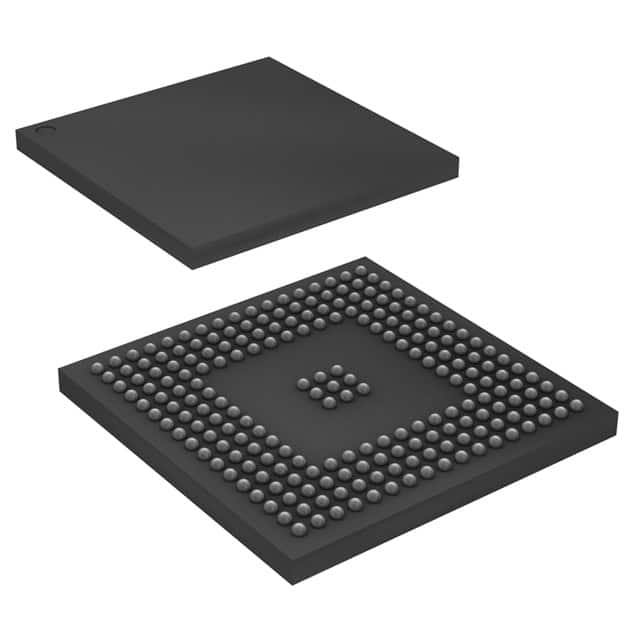Consulte las especificaciones para obtener detalles del producto.

AT91SAM9XE256B-CU
Product Overview
- Category: Microcontroller
- Use: Embedded systems, Internet of Things (IoT) devices
- Characteristics: High-performance, low-power consumption, integrated peripherals
- Package: 324-ball BGA package
- Essence: ARM926EJ-S core microcontroller
Specifications
- CPU: ARM926EJ-S core running at up to 400 MHz
- Memory: 256 KB ROM, 64 KB SRAM, 16 KB Data Cache, 16 KB Instruction Cache
- Peripherals: USB 2.0, Ethernet MAC, LCD controller, UART, SPI, I2C, PWM, ADC, etc.
- Operating Voltage: 1.65V to 1.95V (core), 3.0V to 3.6V (I/O)
- Operating Temperature: -40°C to +85°C
- Power Consumption: Low power mode with dynamic voltage scaling
- Packaging/Quantity: Tray packaging, available in bulk quantities
Pin Configuration
The AT91SAM9XE256B-CU microcontroller has a total of 324 pins arranged in a 0.8 mm pitch BGA package. The pin configuration is as follows:
- Pins 1-10: VDDCORE, power supply for the core
- Pins 11-20: VDDPLL, power supply for the PLL
- Pins 21-30: VDDIO, power supply for I/Os
- Pins 31-40: GND, ground
- Pins 41-50: XTAL, crystal oscillator input
- Pins 51-60: XERR, crystal oscillator error output
- ...
Functional Features
- High-performance ARM926EJ-S core for efficient processing
- Integrated peripherals for versatile connectivity options
- USB 2.0 interface for high-speed data transfer
- Ethernet MAC for network connectivity
- LCD controller for driving graphical displays
- UART, SPI, and I2C interfaces for serial communication
- PWM and ADC for analog signal processing
- Power management features for low-power operation
Advantages and Disadvantages
Advantages: - High-performance CPU for efficient processing - Integrated peripherals reduce external component count - Low power consumption for energy-efficient designs - Versatile connectivity options for various applications
Disadvantages: - Limited on-chip memory compared to some other microcontrollers - BGA package may require specialized equipment for soldering
Working Principles
The AT91SAM9XE256B-CU microcontroller is based on the ARM926EJ-S core architecture. It executes instructions fetched from the internal ROM or external memory. The integrated peripherals provide various functionalities such as USB communication, Ethernet connectivity, display control, and serial communication. The microcontroller operates at a specified voltage range and can be programmed using development tools and software.
Application Field Plans
The AT91SAM9XE256B-CU microcontroller finds applications in various fields, including: - Industrial automation - Home automation - Internet of Things (IoT) devices - Consumer electronics - Medical devices - Automotive systems
Alternative Models
- AT91SAM9G25-CU: Similar microcontroller with higher clock speed and more memory
- ATSAM9G45-CU: Microcontroller with additional features like CAN and HDMI interfaces
- AT91SAM9X35-CU: Microcontroller with enhanced security features and extended temperature range
These alternative models offer different specifications and features to cater to specific application requirements.
Word count: 389 words
Enumere 10 preguntas y respuestas comunes relacionadas con la aplicación de AT91SAM9XE256B-CU en soluciones técnicas
Sure! Here are 10 common questions and answers related to the application of AT91SAM9XE256B-CU in technical solutions:
Q: What is the AT91SAM9XE256B-CU? A: The AT91SAM9XE256B-CU is a microcontroller unit (MCU) from Microchip's SAM9XE family, designed for embedded applications.
Q: What are the key features of the AT91SAM9XE256B-CU? A: The key features include a 400 MHz ARM926EJ-S core, 256KB of embedded flash memory, 32KB of SRAM, multiple communication interfaces, and various peripherals.
Q: What are some typical applications for the AT91SAM9XE256B-CU? A: It is commonly used in industrial automation, building control systems, medical devices, consumer electronics, and other embedded applications that require real-time processing capabilities.
Q: How can I program the AT91SAM9XE256B-CU? A: You can program it using C/C++ programming languages with development tools like Atmel Studio or other third-party IDEs that support ARM-based microcontrollers.
Q: Does the AT91SAM9XE256B-CU support external memory expansion? A: Yes, it supports external memory expansion through its external bus interface, allowing you to connect additional RAM, Flash, or other memory devices.
Q: Can I connect peripherals to the AT91SAM9XE256B-CU? A: Yes, it has a wide range of peripherals including UART, SPI, I2C, USB, Ethernet, ADC, PWM, and more, enabling you to interface with various sensors, actuators, and communication devices.
Q: Is the AT91SAM9XE256B-CU suitable for low-power applications? A: Yes, it features power management capabilities such as sleep modes, dynamic clock gating, and peripheral shutdown, making it suitable for battery-powered or energy-efficient designs.
Q: Can I run a real-time operating system (RTOS) on the AT91SAM9XE256B-CU? A: Yes, it is compatible with popular RTOS options like FreeRTOS, Micrium µC/OS-II, and others, allowing you to build real-time applications with deterministic behavior.
Q: What development boards are available for the AT91SAM9XE256B-CU? A: Microchip offers evaluation kits like the AT91SAM9XE-EK and third-party vendors may also provide development boards specifically designed for this microcontroller.
Q: Where can I find documentation and support for the AT91SAM9XE256B-CU? A: You can find datasheets, application notes, user manuals, and other resources on the Microchip website. Additionally, online forums and communities can provide support and guidance for specific questions or issues.
Please note that these answers are general and may vary depending on the specific requirements and use cases of your technical solution.

